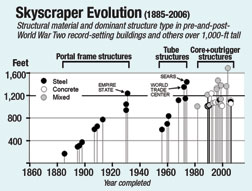Despite all the angst on the fifth anniversary of the event, and contrary to popular belief, the 9/11 attack and the collapse of the World Trade Center towers did not transform the design of tall buildings. It's still business as usual in the world of skyscraper design and construction. And that's the way it should be, for 9/11 was a security failure, not a building performance failure.
| + click to enlarge |
 |
The lesson from 9/11 is not that buildings should be designed to withstand attack by airplanes; it is that criminals should be prevented from flying airplanes into buildings. The nation has responded appropriately to this lesson, by tightening security to the point that an airliner deliberately being flown into a building cannot reasonably be considered a "design event" for the building.
This is not to suggest that nothing at all has changed in the world of tall buildings. Popular concerns, misguided or not, about living or working in an obvious target for terrorists have affected the commercial prospects of iconic projects such as the planned Freedom Tower on the WTC site in New York (which almost certainly could not proceed without direct or indirect government subsidies). And it is not surprising that after 9/11 Donald Trump scaled back his plans to build a record-setting skyscraper in Chicago. But these are exceptions. Tall buildings that do not aspire to iconic status are being designed and built essentially as before.
One might imagine, nonetheless, that at least the specific engineering and architectural features that led to the collapse of the WTC towers and the loss of almost three thousand lives would be outlawed. And indeed it would be possible to eliminate those features and redesign the towers, in retrospect, so that they would not have collapsed on 9/11.
But this approach—changing the rules to prevent a previous failure—is analogous to that of an army preparing for the previous war. The next attack will be different. Design changes specifically aimed at improving performance in an attack exactly like that of 9/11 may be useless or even counter-productive in the face of other, equally plausible, threats. It is impossible to build a skyscraper (at least one that people would want to live or work in) that would be invulnerable to all conceivable attacks.
It is, of course, possible to make buildings safer: Wider exit stairways are better than narrower; more fireproofing is better than less; stronger is almost invariably better than weaker. The present rules in these and other areas, as set by building codes and standards of practice, represent a compromise between the ideal and the practical: We want to be safe, but we also want buildings to be affordable and we don't want to live in bunkers. It is yet possible that the events of 9/11 will cause some re-balancing of these compromises; the profession is trying to learn from the performance of buildings on that day. But the changes would not be aimed at keeping occupants safe when a building is struck by an airplane. Withstanding aircraft attack isn't, and shouldn't be, among the design criteria for most structures.
 Shankar
|
A feature of today's skyscrapers that is frequently touted as a post-9/11 anti-terrorism measure is the service core enclosed within thick concrete walls. But in fact, the trend toward concrete cores predates 9/11/01 by many years. For very tall buildings completed after the Sears Tower (1974) or now under construction, the most common structural system by far is the "core-plus-outriggers" system (see chart). This consists of a concrete-walled core serving as a structural spine in the interior of the building, with stiff arms ("outriggers") engaging "supercolumns" at the perimeter, rather like a person bracing himself by holding walking staffs. The core-plus-outriggers design has replaced the "tube" (no structural core, building stiffened by framing on the perimeter) as the dominant structural system for super-tall buildings. The WTC towers were archetypical tube designs.
The change from the tube to core-plus-outriggers was driven by improvements in the efficiency of concrete core construction and by the greater flexibility in exterior architecture offered by the latter system. The newer buildings do have thick concrete walls enclosing their service cores, but these walls are present for reasons unrelated to fear of attack by airplanes. And in any event, it is by no means clear that core-type structures would necessarily fare better than tube-type buildings in a 9/11-type attack. The oft-heard claim that the concrete core is an effective anti-terrorism measure is not supported by rational analysis.
While attack from the air is not a consideration in skyscraper design today, there have been changes in perimeter-security arrangements for important structures and the way access to the interior of buildings is controlled. These changes are indeed a consequence of the heightened concern for security after 9/11, but they are unrelated to the type of attack that occurred that day. They are, rather, attempts at countering infiltration by terrorists and attacks like the 1993 World Trade Center and 1995 Murrah Federal Building (Oklahoma City) bombings.
The result of the new concern for security is a profusion of bollards and planters outside buildings, turnstiles and barriers inside building lobbies, blast-protection measures near ground level at a few particularly important buildings and, occasionally, marketing-driven, largely arbitrary, more-than-code design features. None of these changes affect the basic building structure. Skyscrapers are being designed and built essentially as they would have been if the 9/11 disaster had not happened. And that's the way it should be.

Post a comment to this article
Report Abusive Comment